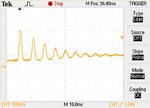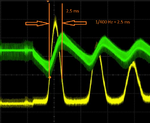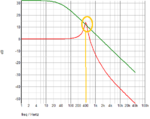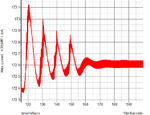ElecDesigner
Member level 5
Hi.
Working on a push-pull convertor that was designed by somebody else. 50Vin 350Vout, 200W.
It appears to work fine under steady load but under stepped load conditions the current drawn is unstable. Attached is a scope waveform showing current drawn when a stepped increase in load occurs.
Any ideas on why I'm not seeing just a single stepped increase in current.

Working on a push-pull convertor that was designed by somebody else. 50Vin 350Vout, 200W.
It appears to work fine under steady load but under stepped load conditions the current drawn is unstable. Attached is a scope waveform showing current drawn when a stepped increase in load occurs.
Any ideas on why I'm not seeing just a single stepped increase in current.






